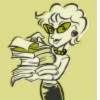 Crews, Nina. 2004. THE NEIGHBORHOOD MOTHER GOOSE. New York: Greenwillow Books. ISBN 0-06-051573-2
Crews, Nina. 2004. THE NEIGHBORHOOD MOTHER GOOSE. New York: Greenwillow Books. ISBN 0-06-051573-2THE NEIGHBORHOOD MOTHER GOOSE is a collection honoring “a centuries-old oral tradition.” A brief author’s note at the end of the book explains the sources Crews used to create her compilation. Her sources include THE OXFORD DICTIONARY OF NURSERY RHYMES, THE ANNOTATED MOTHER GOOSE and her own personal experiences. Though the rhymes are indeed centuries old, the illustrations give this book a contemporary spin. Crews uses color photography to present modern people from a variety of cultures in urban settings. This attachment to modern pictures facilitates readers’ connection with Mother Goose rhymes and is sure to help dispel the misconception that Mother Goose rhymes are irrelevant to today’s children. This connection could also lead to meaningful comparisons between and among cultures. The subjects of the photographs include a diverse group of people. In addition, the people’s faces match the mood of the rhyme. For example, one mother’s expression is fittingly amazed as her son “pulled out little fishes” from his ear. Some of the poems included are known as rhymes, while others may best be recognized as songs (Ring Around the Rosie) or tongue twisters (Peter Piper). The table of contents serves as an index, as each rhyme is listed alphabetically rather than sequentially. This method of organization facilitates the reader’s ability to search for a specific rhyme.
This collection of Mother Goose rhymes is highly recommendation for readers ages 2-8.




